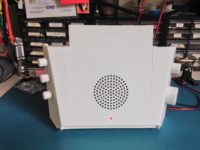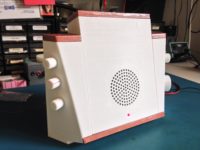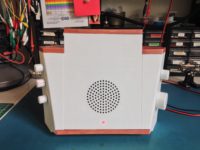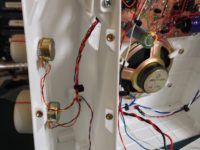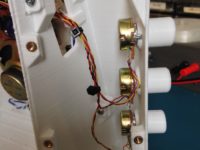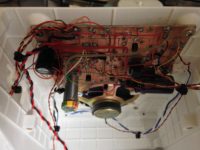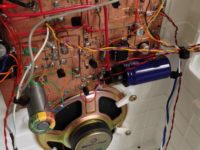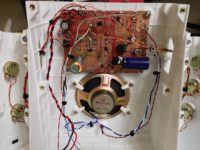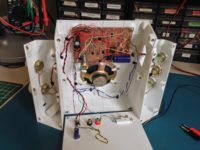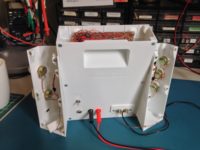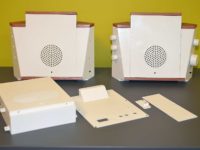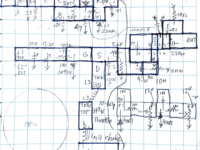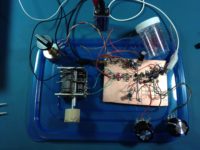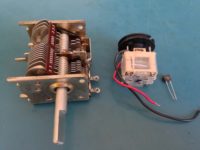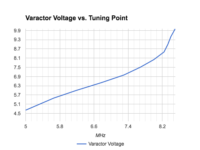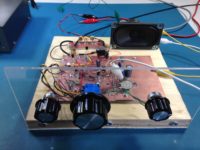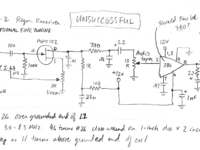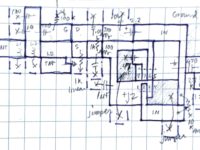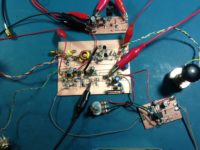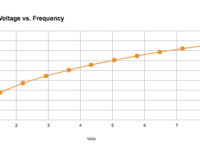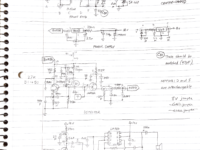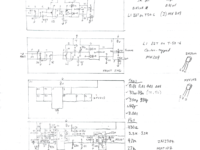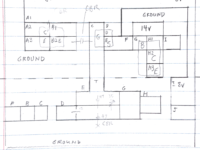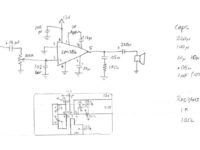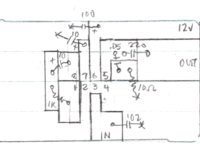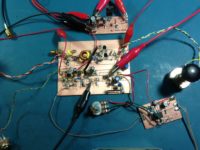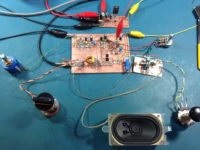I’m embarrassed that it’s taken me this long to get this post out. It’s currently nearing the end of August, and I started this project in mid-March. It was really wrapped up in late April, but I had to wait for parts to come from Asia for the enclosure, and they didn’t arrive until June, and then the summer arrived. Oh well.
I benefited from the experience of the first build: I got a good sense of how much space the individual components required, and how to best position the sub-assemblies relative to each other. I had also received my Prusa i3 Mk 2 3D printer with the intention of making boxes for these projects. My thinking evolved from making a presentable box for the radio to thinking about how I actually used the radio, and how to position the controls for most comfort and efficiency.
Here’s my design journal:
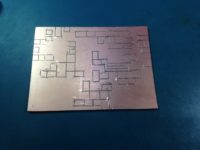
This build will use mainly surface mount components on a board which is half the size of the first one. It measures 100x75mm. The islands that I cut in the copper are sized for surface mount resistors and capacitors. Since most of my experimentation was on the first build, I had confidence to concentrate the components. Radios that have closer connections between components are also usually better performers.
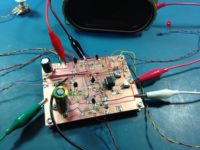
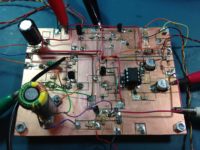
A storm took down the antenna wire attached to the front of the house last night. The hemp string attaching it to the tree gave way. The wire (from a CAT5 cable) is very strong and has lasted two years without breaking. Environment Canada recorded wind gusts up to 109 km/h which is approaching minor hurricane speed. Main vertical antenna in the back yard is unaffected.
Completed most of the components and peripherals. After a couple of minor revisions, this radio now works — even better than the first! Although band conditions are very bad (minor storm and geomagnetic instability), I’m still able to receive a couple of stations over the noise and fading in and out. Fidelity seems much better on this radio.

Enclosure
”It’s not just a box!“
If you’ve ever spent any time in front of a regenerative radio, it doesn’t take long to understand why, despite the excellent sound, dynamic range and overall performance of the design, most radios that work in the medium and high frequency broadcast and shortwave bands are not regens. They’re use different designs that allow the user to tune to a station and then leave it. One big disadvantage of regens is the fact that you have to constantly and carefully adjust the feedback and tuning to get the best reception. There’s a challenge to pulling out a distant signal using one of these radios, and you need two hands to do it.

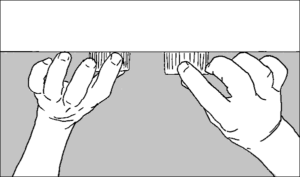
That brings up an ergonomic issue: conventional radios are boxes with a speaker and control widgets facing outward from the front. This arrangement serves the average listener reasonably well; the radio is tuned once or twice in an hour and most of the time the listener is not touching the radio at all, so it really doesn’t matter where the controls are.
However, because regenerative radios require constant attention, I found that my hands and arms started getting a little uncomfortable after 15 minutes or so of constant adjustment of the dials. After a few days of using it and thinking about it, I realized that if the controls were on the front, an operator’s hand/wrist/arm had to be contorted into an unnatural and eventually uncomfortable position.
So my next question was “if the radio box resulted in discomfort, what would be more comfortable?” I surmised that if I were able to turn the rotary controls on an angle so that they don’t face directly at the user, but rather faced perpendicular to the user’s forearm, it would result in a more natural control position. I also thought that the front of the radio should be angled upwards slightly, since the radio will be on a desktop: on a ‘box’ radio that is positioned on a desk in front of a user, the speaker is aimed at the listener’s upper chest. The speaker should be pointed directly at the listener’s head, since that’s where her ears are!
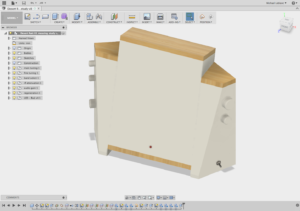
Here’s the design as it looked using Fusion 360 in the middle of my development cycle. The design consists of a main centre unit, which holds the circuit board and the speaker, and two side pieces which are bolted to the main cabinet and which hold the user interface items. The enclosure is meant to be entirely 3D printed. The wood too!
Adding a Relay for Band Changing
March 23:
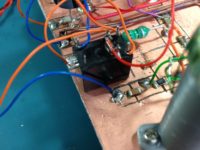
The radio is capable of tuning to two bands: from around 6.5-8MHz and from 9-12MHz. This is done by flipping a toggle switch. The switch itself is some distance from the circuit board, which means that the long wires to and from the switch are likely to adversely affect the circuit. After playing with it al fresco, I made one modification to reduce the length of wire to and from the circuit: I replaced the long leads (20cm) for the band switch with much shorter leads (4cm) to an HK23F-DC12V relay. The relay is actuated by the band switch on the far side of the radio, but the RF signals that are re-routed in the band switch are much shorter. This probably increases Q (makes for sharper tuning) and lowers the total capacitance of the band switch circuit to the values defined by the two small 10pF and 47pF caps.
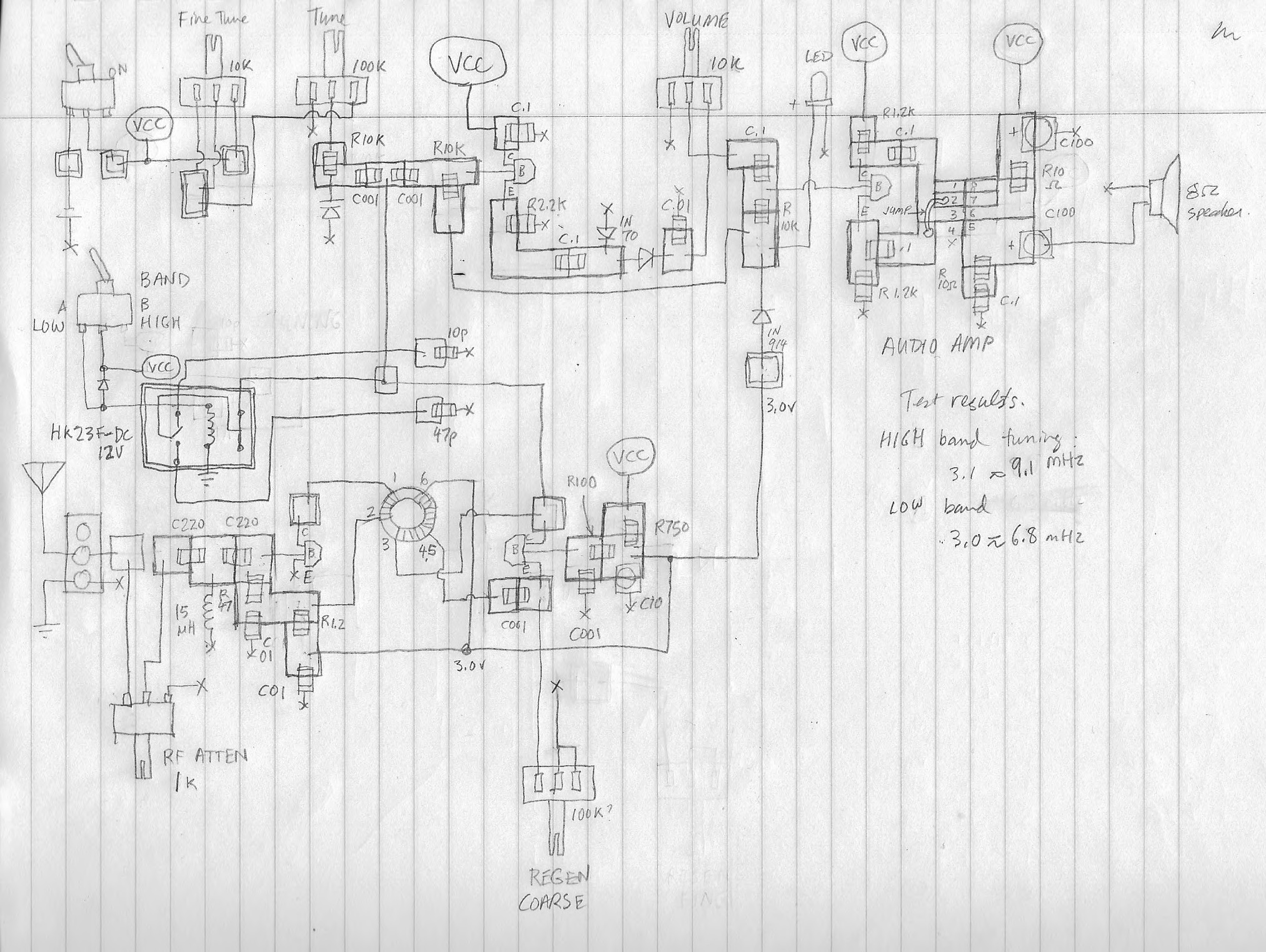
Designing the Cabinet for Production
By mid-April, I had printed a draft enclosure to see if it everything would fit together.
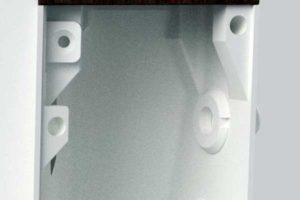
Printing in 3D has its own opportunities and limitations. Because it prints up from the bed layer by layer, certain structures such as overhangs longer than about 1cm are not possible without first defining support structures that can be removed after the print is completed. However, careful design can reduce and sometimes even eliminate support material structures. The Prusa i3 Mk2 is capable of printing 45° overhangs. In the case of this enclosure, very few supports were used; if there were overhangs, such as the surfaces that hold the threaded brass inserts, these were extended to between 30 and 40°, as you can see in the detail of this rendering.
- Centre: need some strengthening fixed
- Circuit board: use 2.0 mm holes, 4mm deep, add 1.5mm washers fixed
- Band Switch: placement guides not large enough: block is 15 x 31 mm fixed
- [Small, medium knobs need at least 5.9 mm dia -they appear to be 5.8mm – is this due to draft mode printing?]
- Knobs need to have longer skirts – try 4mm fixed
- add dial dots on main tuning fixed
- add diode in front of VCC not done.
- add headphone jack on back? not done.
- swap out pots for new ones fixed
- Speaker magnet collides with centre back – replaced
This last point was a surprise; although I thought I had measured everything, even to the point of modelling-in the components, I didn’t model the speaker correctly and the test fit quickly showed that the back panel wouldn’t fit with this large speaker. So it just goes to show: you can have fantastic design software but there’s just no replacement for printing one out and doing a test fit.
Edit: Actually, I printed two full copies in the 0.20 mm “normal” detail setting before printing the final using the 0.15mm “optimal” detail.
Here’s a Fusion 360 render of the back:
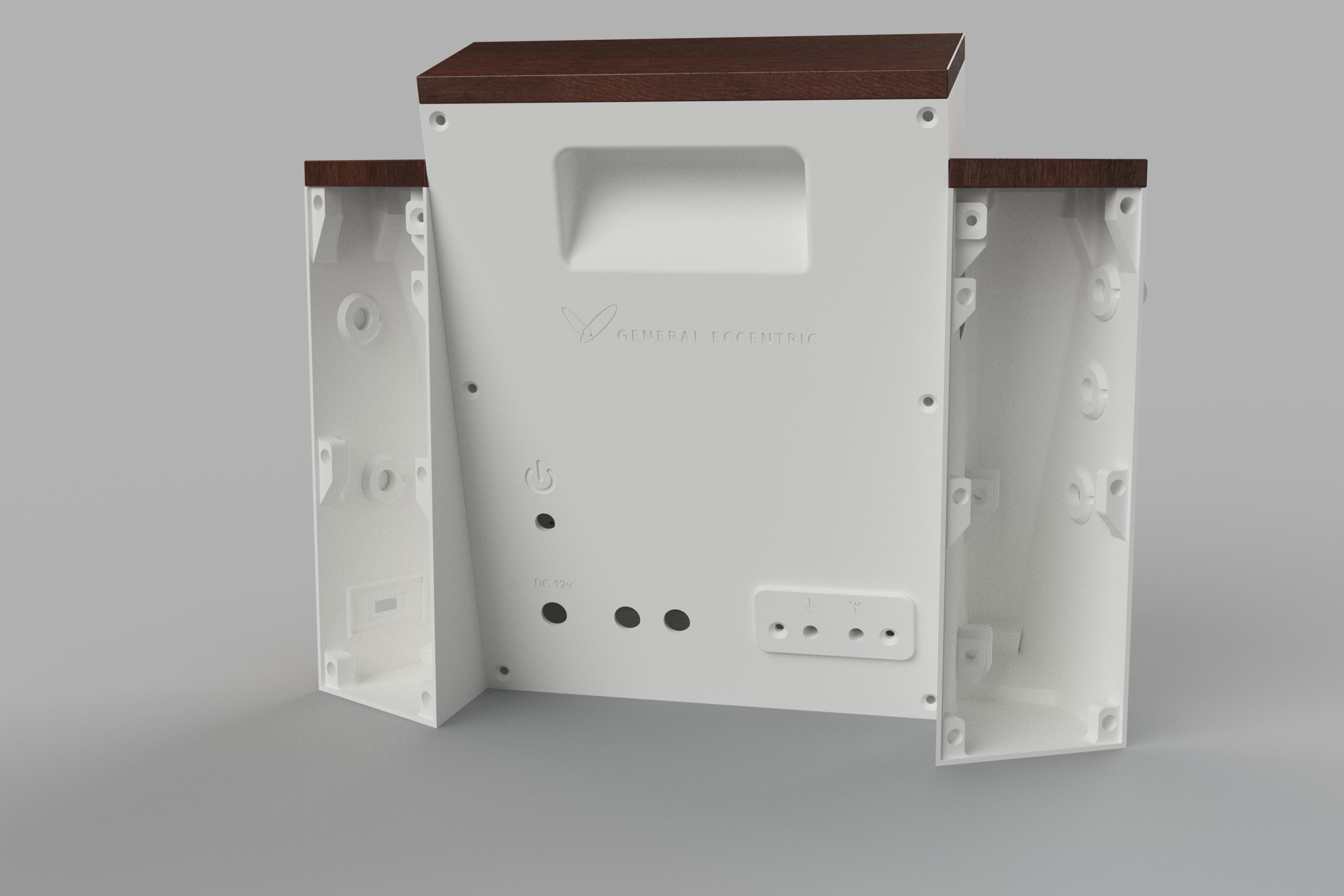
- Centre re-designed with web strengtheners
- replaced old grille with Dieter Rams 1973 grille: “steal from the best”
- added Dial Dots around the Main Tune pot on the right UI
- vertical web strengtheners will not print in Draft mode, printed in normal mode
- fashioned clips and mounted new circular speaker
- swapped out old potentiometers
- stained wood pieces
- added “UI clips” on the cable holes to bring the shells closer together
- listened in the evening many strong stations… great sound! It’s amazing how much better a speaker can sound when you put it in a box.
- tried listening in morning: unable to tune. Much back and forth. Problem seemed to be located in Regen circuitry & pot. Replaced transistor closest to Regen pot. Finally, replaced the Regen pot. Pot went bad!
- bundled cables with nylon ties
- urethaned wood
The 3D printed wood pieces were printed from Spool3D “light brown wood” PLA filament. Spool3D is a Canadian company and I buy all my filament from them. My only complaint is that I’ve never been able to get a proper answer from them on what Munsell values they use for their coloured filaments.

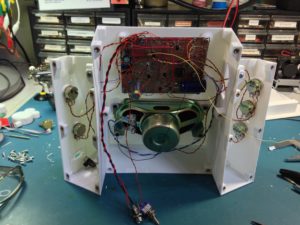
The wood colour is, as the name suggests, “light brown”, and I was able to stain it (after sanding) with three coats and then lightly give it one coat of urethane. The rest of the cabinet used Spool3D White PLA.
The three sections are screwed together using M3 screws into brass inserts. The inserts are placed on the end of a hot soldering iron, and after about 5 seconds you can press them into place in the plastic and once they cool, they are bonded into the plastic. I found this technique on Youtube.
One last change was the speaker and speaker grille. My initial idea for the grille was to make holes that mimic the dot-dash of morse code. When I transitioned to a smaller round speaker, I stole Dieter Ram’s TP1 record player grille design. In the end I made one final further refinement by making the grille slightly convex.
The final enclosure was printed in “natural” PLA. This was a mistake, because natural PLA is slightly translucent, and I liked the white material better. I resorted to sanding, priming and spray painting the final print—a lot of work that could have been avoided had I printed in white. While PLA is great to print with, it’s difficult to sand and otherwise work with. And because PLA has a melting point of 60° C, I can’t place it in hot environments like a closed-up car in the summer time.
One last observation: it’s amazing how much better a radio sounds when you place the speaker in an enclosure. Or a box.
Here’s a short video of the radio. Unfortunately it was done on an evening with a K index of 4 (unstable geomagnetic conditions). More photos below the video.
